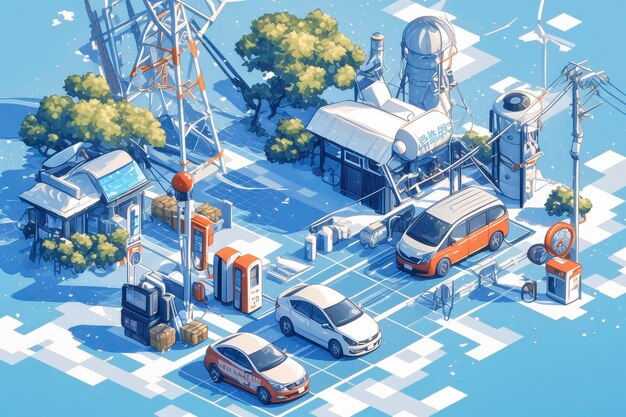Disaster Resilience: Smart City Tech for Emergency Response

Smart city technologies significantly enhance disaster resilience by improving emergency response and recovery efforts through real-time data, coordinated communication, and efficient resource allocation.
Disaster resilience: How smart city technologies can improve emergency response and recovery efforts is a critical concern for communities worldwide. Smart city technologies are revolutionizing how cities prepare for, respond to, and recover from disasters.
Understanding Disaster Resilience in Smart Cities
Disaster resilience refers to a community’s ability to withstand, adapt to, and recover from the impacts of natural or man-made disasters. Smart cities, leveraging technology and data, are better equipped to enhance this resilience.
The integration of advanced technologies allows for more effective and efficient disaster management.
Key Components of Disaster Resilience
Effective disaster resilience involves several interconnected components that work together to minimize the impact of disasters and facilitate quicker recovery. Some key aspects include:
- Enhanced preparedness through predictive analytics
- Rapid and coordinated emergency response systems
- Efficient resource allocation and management
- Robust communication networks for public alerts
The Role of Smart City Technologies
Smart city technologies play a crucial role in enhancing disaster resilience. By leveraging IoT devices, data analytics, and integrated communication systems, cities can better anticipate, respond to, and recover from disasters.
These technologies enable real-time monitoring and situational awareness, allowing for more informed decision-making and efficient resource deployment.

Smart cities improve their disaster preparedness by implementing technological measures and raising awareness among citizens. This ensures a faster and more effective response, reducing the adverse impacts of disasters.
Improving Emergency Response with Smart Technologies
Emergency response is significantly enhanced through smart city technologies, enabling quicker and more effective responses to disasters.
These technologies provide real-time information and facilitate coordinated efforts among various stakeholders.
Real-Time Monitoring and Alert Systems
One of the primary benefits of smart cities is the ability to monitor conditions in real-time. Sensors and IoT devices can collect data on weather, traffic, and infrastructure, providing valuable insights during emergencies.
Integrated alert systems can quickly disseminate information to the public, ensuring timely evacuations and safety measures.
Enhanced Communication and Coordination
Smart city technologies improve communication and coordination among emergency responders, government agencies, and citizens. Some key communication tools include:
- Centralized communication platforms
- Mobile apps for real-time updates and reporting
- Social media monitoring for situational awareness
In conclusion, by leveraging real-time monitoring and enhanced communication, smart cities can significantly improve their emergency response capabilities. This results in faster response times, better coordination, and more effective resource allocation.
Smart Infrastructure for Disaster Preparedness
Smart infrastructure plays a vital role in disaster preparedness, ensuring that critical systems remain functional and resilient during emergencies.
This leads to better protection of resources and faster recovery.
Investing in resilient infrastructure can significantly reduce the impact of disasters and facilitate quicker recovery.

Resilient Power Grids
Traditional power grids are often vulnerable during disasters. Smart grids, equipped with advanced sensors and automation, can reroute power and isolate damaged areas, ensuring continuous power supply to critical facilities.
Energy storage solutions and backup power sources further enhance the resilience of power grids.
Water Management Systems
Smart water management systems can monitor water levels, detect leaks, and manage water distribution during disasters. These systems ensure a reliable water supply for firefighting and other emergency needs, as well as prevent water loss
- Real-time water level monitoring
- Automated leak detection
- Smart water distribution
By investing in smart infrastructure, cities can ensure that their critical systems remain functional and resilient during disasters. This reduces the impact of emergencies and speeds up recovery efforts.
Data Analytics for Predictive Disaster Management
Data analytics is a powerful tool for predictive disaster management, enabling cities to anticipate and prepare for potential disasters. Predictive disaster management improves preparedness and enables better resource allocation.
By analyzing historical and real-time data, cities can improve their disaster preparedness and response strategies.
Predictive Modeling and Analysis
Predictive modeling involves using historical data to forecast the likelihood and potential impact of future disasters. Machine learning algorithms can analyze various factors, such as weather patterns, seismic activity, and infrastructure conditions, to identify potential risks.
This analysis can provide valuable insights for developing targeted preparedness plans and evacuation strategies.
Risk Assessment and Vulnerability Mapping
Smart cities can use data analytics to assess risks and create vulnerability maps. This involves identifying areas and populations that are most vulnerable to specific types of disasters. Such mapping allows resources to be allocated more efficiently.
- Identifying vulnerable populations
- Mapping high-risk areas
- Assessing infrastructure vulnerabilities
Data analytics provides valuable insights for predictive disaster management, allowing cities to anticipate and prepare for potential disasters. Effective prediction and planning increase preparedness and efficient resource allocation.
Community Engagement and Education
Community engagement and education are essential components of disaster resilience, empowering citizens to take proactive measures and contribute to recovery efforts. They foster a sense of shared responsibility and improve overall preparedness.
Involving the community in disaster preparedness enhances resilience and ensures a coordinated response.
Public Awareness Campaigns
Public awareness campaigns can educate citizens about potential risks, evacuation procedures, and emergency contacts. These campaigns can use various channels, such as social media, public service announcements, and community events, to reach a broad audience.
In addition, educating citizens about effective safety measures can significantly reduce the impact of disasters.
Citizen Reporting and Collaboration Platforms
Smart city technologies enable citizens to report incidents and share information with authorities through mobile apps and online platforms. These platforms can collect data on infrastructure damage, stranded individuals, and other critical issues.
Citizen reporting and collaboration platforms allow for crowdsourced situational awareness.
By involving the community in disaster preparedness, cities can enhance resilience and ensure a coordinated response. Community engagement and education foster a sense of shared responsibility and improve overall preparedness.
Challenges and Future Directions
Despite the numerous benefits of smart city technologies for disaster resilience, several challenges remain.
Addressing these challenges is crucial for maximizing the potential of smart cities in disaster management.
Data Privacy and Security Concerns
The collection and use of large amounts of data raise concerns about privacy and security. Cities must implement robust data protection measures to safeguard sensitive information and prevent misuse.
- Data encryption
- Access controls
- Compliance with privacy regulations
Technological Infrastructure and Interoperability
Ensuring interoperability between different systems and technologies is essential for creating a seamless disaster response network. Cities must invest in standardized protocols and open platforms to facilitate communication and data sharing.
Additionally, maintaining reliable technological infrastructure during power outages and network disruptions is crucial.
Future Directions
As technology continues to advance, smart cities will have even more powerful tools for enhancing disaster resilience. Some future directions include integrating artificial intelligence for more accurate predictions, using drone technology for rapid damage assessment, and developing advanced robotics for search and rescue operations.
Ongoing innovation and investment in smart city technologies are essential for building more resilient communities.
| Key Point | Brief Description |
|---|---|
| 🚨Real-Time Monitoring | Sensors and IoT devices monitor weather, traffic, and infrastructure. |
| 🛡️Resilient Infrastructure | Smart grids ensure continuous power. Smart water systems manage water distribution. |
| 📊Data Analytics | Predictive models forecast disasters, helping cities prepare better. |
| 🤝Community Engagement | Educating citizens and involving them improves response and preparedness. |
Frequently Asked Questions
Smart city technologies improve disaster preparedness through real-time monitoring, predictive data analytics, and enhanced communication systems, allowing cities to anticipate and mitigate the impact of potential disasters.
Smart infrastructure, such as resilient power grids and water management systems, ensures critical systems remain functional, improves resource allocation, and speeds up the recovery process following a disaster.
Data analytics uses historical and real-time information to predict the likelihood and potential impact of disasters. This enables cities to develop targeted preparedness plans and efficiently allocate resources.
Community engagement is vital because it empowers citizens with disaster preparedness knowledge, fosters shared responsibility, and enables crowdsourced situational awareness through citizen reporting and collaboration platforms.
Key challenges include addressing data privacy and security concerns, ensuring interoperability between different technological systems, and maintaining functional infrastructure during power outages or network disruptions.
Conclusion
Smart city technologies offer unprecedented opportunities to enhance disaster resilience: How smart city technologies can improve emergency response and recovery efforts. By leveraging real-time data, resilient infrastructure, predictive analytics, and community engagement, cities can better prepare for, respond to, and recover from disasters, building safer and more resilient communities.





